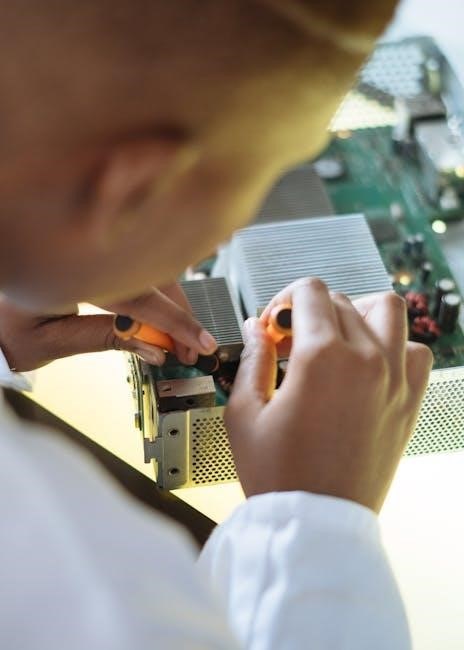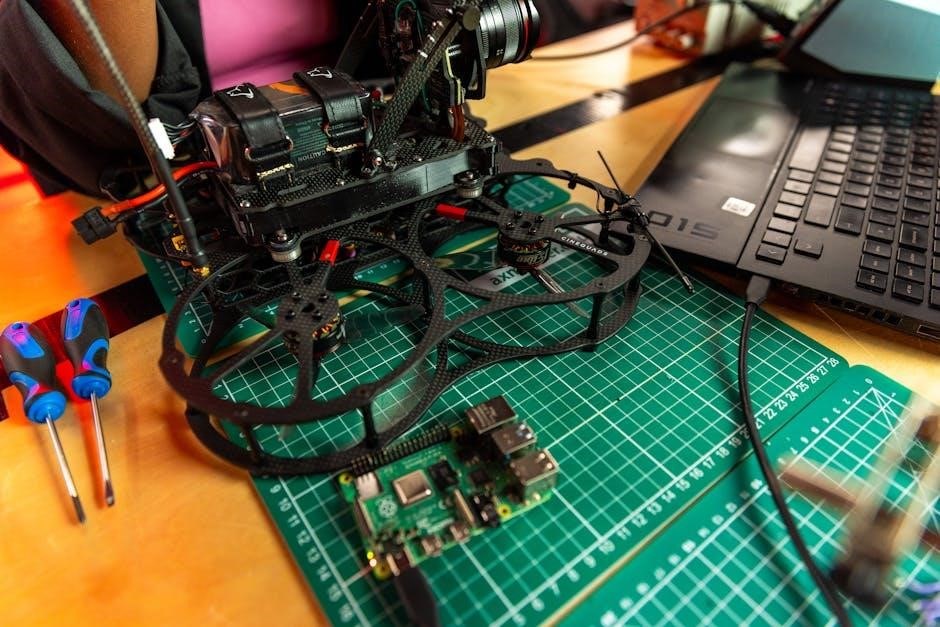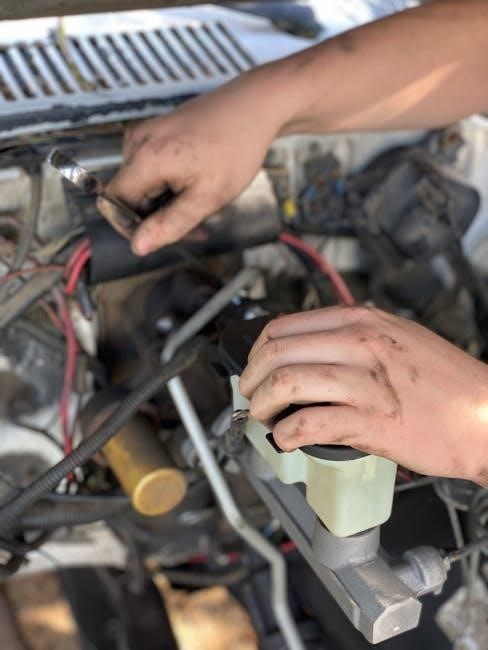The Crucible: A Play in Four Acts ー Comprehensive Guide
Arthur Miller’s The Crucible, a powerful drama, is readily available as a PDF download. Numerous online resources offer the full text, including character guides and study materials.
These PDF versions, often in public domain, facilitate easy access for students and enthusiasts alike. Download options include files like “the-crucible-arthur-miller;pdf”, sized around 1139 kb.
Exploring this classic play’s themes of hysteria and injustice is now more convenient than ever with these accessible digital copies.
Arthur Miller’s The Crucible, first performed in 1953, remains a profoundly relevant and frequently studied dramatic work. This four-act play transcends its historical setting – the Salem witch trials of 1692 – to explore universal themes of mass hysteria, power, and individual conscience. The play’s enduring power lies in its ability to resonate with audiences across generations, prompting critical reflection on societal pressures and the dangers of unchecked authority.
Originally conceived as an allegory for the McCarthyism of the 1950s, The Crucible examines the devastating consequences of false accusations and the erosion of civil liberties. Miller masterfully portrays a community consumed by fear and paranoia, where personal vendettas and religious extremism fuel a climate of suspicion. The play’s characters grapple with difficult choices, forced to confront their own moral boundaries in the face of overwhelming pressure.
Fortunately, accessing this seminal work is remarkably easy. Numerous online platforms offer the complete text of The Crucible as a readily available PDF download. Resources like those mentioned provide convenient access to the script, facilitating study and analysis. Files such as “the-crucible-arthur-miller.pdf” (approximately 1139 kb) are commonly found, offering a portable and accessible format for engaging with Miller’s masterpiece. These digital versions often include supplementary materials, enhancing the reading experience.
II. Historical Context: The Salem Witch Trials
The Salem witch trials, which transpired in colonial Massachusetts between 1692 and 1693, serve as the chilling historical backdrop for Arthur Miller’s The Crucible. Triggered by a combination of religious extremism, social anxieties, and personal disputes, the trials resulted in the accusations, trials, and executions of over twenty individuals, primarily women, accused of witchcraft.
The initial accusations, brought forth by a group of young girls, quickly spiraled into a frenzy of fear and paranoia. Spectral evidence – testimony based on visions and dreams – was readily accepted in court, contributing to the escalating number of convictions. This atmosphere of hysteria allowed long-standing grudges and power struggles to manifest as accusations of demonic influence.
While Miller’s play isn’t a strictly factual account, it draws heavily from the documented events of the Salem trials, capturing the atmosphere of fear and injustice. Accessing primary and secondary sources relating to this period enhances understanding of the play’s historical roots. Fortunately, resources offering historical context, alongside the play’s text in PDF format – such as downloadable versions of The Crucible – are widely available online. These PDFs, like “the-crucible-arthur-miller.pdf”, provide a convenient way to study both the play and its historical foundation.
III. Arthur Miller: Author Biography
Arthur Miller (1915-2005) was a towering figure in 20th-century American theatre, renowned for his insightful explorations of the American Dream, morality, and social responsibility. Born in New York City, Miller’s early life was marked by economic hardship during the Great Depression, experiences that profoundly influenced his writing.
He achieved widespread acclaim with plays like All My Sons (1947) and Death of a Salesman (1949), establishing himself as a leading voice in American drama. However, it was The Crucible (1953) that cemented his legacy, particularly in light of the McCarthyist era’s anti-communist fervor.
Written as a response to the Red Scare, The Crucible utilizes the Salem witch trials as an allegory for the political persecution of suspected communists. Miller himself faced scrutiny from the House Un-American Activities Committee, refusing to name alleged communists and facing a conviction for contempt of Congress – later overturned.
His works, including The Crucible, are frequently studied and performed globally. Conveniently, the play’s text is readily available as a PDF download, such as “the-crucible-arthur-miller.pdf”, allowing for easy access to his powerful and enduring drama. Studying Miller’s biography enriches the understanding of the play’s context and themes.
IV. The Crucible: Plot Summary ⏤ Act I
Act I of Arthur Miller’s The Crucible introduces the village of Salem, Massachusetts, in 1692, and the escalating hysteria surrounding accusations of witchcraft. The play opens with Reverend Parris discovering his daughter, Betty, and other girls seemingly bewitched in the forest.
Rumors of witchcraft quickly spread, fueled by the Reverend’s fear for his reputation and the community’s existing religious anxieties. Abigail Williams, Parris’s niece, emerges as a central figure, initially denying any wrongdoing but subtly manipulating the situation.
Reverend Hale, an expert in witchcraft, is summoned to investigate. His arrival intensifies the pressure, as he attempts to discern the truth through questioning. Tituba, Parris’s enslaved woman, is coerced into confessing to witchcraft, naming others to save herself, and thus igniting a chain reaction of accusations.
The act concludes with Abigail and the other girls turning the accusations against Tituba and other marginalized members of the community. Access to the full text as a PDF, like “the-crucible-arthur-miller.pdf”, allows for a detailed examination of this pivotal opening act and the seeds of the unfolding tragedy.
V. The Crucible: Plot Summary ⏤ Act II
Act II of The Crucible shifts focus to the strained relationship between John and Elizabeth Proctor. Months have passed since the events of Act I, and the court, led by Deputy Governor Danforth, continues to examine alleged witchcraft cases.
The act centers around a tense confrontation between John and Elizabeth, revealing their emotional distance and the weight of suspicion surrounding them. Elizabeth is accused by Abigail Williams, motivated by a past affair with John and a desire for revenge.
Reverend Hale returns to the Proctors’ home, questioning their piety and seeking evidence of their faith. He attempts to uncover the truth, but John’s confession of his adultery with Abigail complicates matters, casting further doubt on his character.
The act culminates in Elizabeth’s arrest, based on Abigail’s accusations and a poppet—a doll—found in the Proctor household. This pivotal moment underscores the escalating hysteria and the fragility of justice. Studying the complete play as a PDF, such as the readily available “the-crucible-arthur-miller.pdf”, provides a deeper understanding of the act’s complexities.
VI. The Crucible: Plot Summary ー Act III
Act III of The Crucible is a dramatic courtroom showdown, marking a turning point in the play’s escalating conflict. John Proctor attempts to expose Abigail Williams’s deceit by revealing their past affair and her motivations for falsely accusing Elizabeth.
He presents Mary Warren, Abigail’s servant, as a witness to the girls’ fabricated claims of being afflicted by witchcraft. However, Abigail and the other girls skillfully manipulate the court, turning the accusations back on Mary and ultimately, on John himself.
Reverend Hale, increasingly disillusioned with the proceedings, attempts to reason with the court, but his efforts are thwarted by the rigid beliefs of Deputy Governor Danforth. The act features intense interrogations and accusations, highlighting the power dynamics and the dangers of mass hysteria.
Mary Warren, under immense pressure, ultimately betrays John and reverts to supporting Abigail’s claims. John, in a desperate attempt to save his wife, confesses to lechery, but this confession only serves to further incriminate him. Accessing the full text as a PDF, like “the-crucible-arthur-miller.pdf”, enhances comprehension of this pivotal act’s intricate details.
VII. The Crucible: Plot Summary ー Act IV
Act IV of The Crucible unfolds in a stark and desolate jail, months after the events of Act III. The town is gripped by unrest as rumors of rebellion circulate, fueled by the increasingly apparent injustice of the witch trials. Abigail has vanished with Parris’s money, exposing her fraudulent scheme.
John Proctor and Rebecca Nurse await execution, maintaining their integrity despite immense pressure to confess falsely and save their lives. Reverend Hale returns, desperately urging the accused to confess, believing any lie is better than death.
Elizabeth Proctor, brought in to speak with John, unknowingly contributes to his internal conflict by initially failing to defend his character; However, she later acknowledges her own failings and encourages him to choose his own conscience.
Ultimately, John Proctor chooses to die with his name intact, refusing to sign a false confession. His courageous act of defiance serves as a powerful condemnation of the court’s corruption and the destructive nature of hysteria. Studying the complete play, readily available as a PDF, such as “the-crucible-arthur-miller.pdf”, provides a deeper understanding of this tragic conclusion.
VIII. Major Characters: John Proctor
John Proctor is arguably the central tragic hero of Arthur Miller’s The Crucible. A respected, though flawed, farmer in Salem, Proctor grapples with guilt stemming from a past affair with Abigail Williams. This secret fuels much of the play’s conflict and ultimately contributes to his downfall.
Initially presented as a stern and independent man, Proctor’s character undergoes significant development as he confronts the escalating hysteria of the witch trials. He is a man of principle, fiercely protective of his reputation and unwilling to compromise his integrity.

Proctor’s attempts to expose Abigail’s lies and defend his wife, Elizabeth, demonstrate his courage and commitment to truth. However, his past indiscretion is weaponized against him, creating a moral dilemma that tests his resolve.
His ultimate decision to sacrifice his life rather than falsely confess highlights his unwavering commitment to honesty and personal honor. A comprehensive understanding of Proctor’s complexities is best achieved through a close reading of the play, easily accessible in PDF format, like “the-crucible-arthur-miller.pdf”, allowing for detailed character analysis.
IX. Major Characters: Abigail Williams
Abigail Williams serves as the primary antagonist in Arthur Miller’s The Crucible, a manipulative and vengeful young woman whose actions ignite the Salem witch trials. Driven by a desire for power and fueled by unrequited love for John Proctor, she orchestrates a campaign of false accusations to eliminate her rivals and reclaim Proctor’s affection.
Abigail is portrayed as a master of deception, skillfully exploiting the religious fervor and societal anxieties of Salem to her advantage. She possesses a remarkable ability to manipulate others, particularly the vulnerable young girls, whom she controls through fear and intimidation.
Her accusations, initially targeting Tituba and other marginalized members of the community, quickly escalate, ensnaring innocent individuals and plunging Salem into chaos. Abigail’s relentless pursuit of her own desires demonstrates a chilling lack of empathy and moral conscience.
Understanding Abigail’s motivations and manipulative tactics is crucial to comprehending the play’s central themes. Accessing the full text of The Crucible in PDF format, such as “the-crucible-arthur-miller.pdf”, provides a detailed examination of her character and her devastating impact on Salem.
X. Major Characters: Reverend Hale
Reverend John Hale arrives in Salem as an expert in witchcraft, summoned to investigate the claims of demonic possession. Initially confident in his abilities and eager to eradicate evil, Hale embodies the intellectual arrogance and rigid beliefs of the Puritan society.
As the trials progress, however, Hale undergoes a significant transformation. Witnessing the injustice and hysteria firsthand, he begins to question the validity of the accusations and the methods employed to uncover “witches.” His growing skepticism leads him to challenge the authority of the court and defend the accused.
Hale’s internal conflict—between his faith in the established order and his growing awareness of the corruption within it—forms a central dramatic tension in The Crucible. He attempts to salvage the situation, urging confessions to save lives, but ultimately recognizes the futility of his efforts.
A thorough understanding of Hale’s character arc requires a close reading of the play. Conveniently, the complete text of The Crucible is available as a PDF, like “the-crucible-arthur-miller.pdf”, allowing for detailed analysis of his evolving perspective and moral struggle.
XI. Major Characters: Elizabeth Proctor
Elizabeth Proctor stands as a pillar of integrity and moral strength within the tumultuous events of The Crucible. She is a respected member of the Salem community, known for her piety and reserved nature. However, her life is irrevocably altered by the accusations of witchcraft leveled against her and the subsequent investigation.
Elizabeth’s quiet dignity and unwavering honesty contrast sharply with the manipulative tactics of Abigail Williams. Though initially suspected due to John Proctor’s past affair with Abigail, Elizabeth refuses to compromise her principles to save herself. Her commitment to truth and justice ultimately leads to her tragic fate.
Throughout the play, Elizabeth embodies the devastating consequences of false accusations and the power of societal hysteria. Her unwavering faith in her husband, despite his flaws, highlights the enduring strength of their bond.
A comprehensive understanding of Elizabeth’s character is crucial to grasping the play’s central themes. Accessing the full text of The Crucible as a PDF, such as “the-crucible-arthur-miller.pdf”, allows for a detailed examination of her nuanced portrayal and profound impact on the narrative.

XII. Key Themes: Hysteria and Mass Panic
Hysteria and mass panic are arguably the most dominant themes in Arthur Miller’s The Crucible. The play vividly depicts how fear and suspicion can rapidly consume a community, leading to irrational accusations and unjust condemnations. This descent into chaos is fueled by the manipulative actions of individuals like Abigail Williams, who exploit the prevailing anxieties to achieve personal gain.
The Salem witch trials, as portrayed in the play, demonstrate the dangers of unchecked authority and the suppression of individual reason. As accusations escalate, the court and community become increasingly reliant on spectral evidence and unsubstantiated claims, effectively abandoning due process.

Miller masterfully illustrates how easily truth can be distorted and innocence destroyed when collective fear takes hold. The play serves as a cautionary tale about the fragility of societal order and the importance of critical thinking.
A thorough exploration of these themes requires a close reading of the text. Conveniently, the complete play is available as a PDF, like “the-crucible-arthur-miller.pdf”, enabling detailed analysis of the escalating hysteria and its devastating consequences.
XIII. Key Themes: Power and Authority
Power and authority are central to understanding the dynamics within The Crucible. The play examines how these forces can be wielded both legitimately and abusively, shaping the fates of individuals and the community as a whole. Reverend Parris, for instance, is primarily concerned with maintaining his position and authority within Salem, often prioritizing his reputation over justice.

The court, led by Deputy Governor Danforth, represents the formal authority of the colonial government. However, Danforth’s unwavering belief in his own judgment and his refusal to consider dissenting voices contribute to the escalating tragedy. He embodies the dangers of inflexible authority and the suppression of truth in the name of order.

Abigail Williams also demonstrates a different form of power – the power of manipulation and deceit. She skillfully exploits the existing power structures to accuse and condemn those who threaten her, highlighting the vulnerability of individuals in the face of unchecked influence.
Analyzing these power dynamics is greatly aided by access to the full text. Numerous online sources offer The Crucible as a PDF, such as “the-crucible-arthur-miller.pdf”, facilitating in-depth study.
XIV. Key Themes: Reputation and Honor
Reputation and honor are profoundly significant themes in The Crucible, driving many characters’ actions and ultimately contributing to the play’s tragic outcome. In the rigidly Puritan society of Salem, a person’s standing within the community was paramount, and accusations of witchcraft could irrevocably destroy one’s name.
John Proctor’s struggle exemplifies this theme. He desperately attempts to salvage his reputation after his affair with Abigail Williams is revealed, fearing the loss of respect and social standing. His internal conflict centers on whether to confess falsely to save his life or maintain his integrity and face execution.
Elizabeth Proctor also understands the weight of reputation, striving to maintain her honesty and moral standing despite the accusations leveled against her. The play demonstrates how easily reputations can be tarnished by false accusations and the devastating consequences that follow.
Accessing the complete text of The Crucible, readily available as a PDF download – for example, “the-crucible-arthur-miller.pdf” – allows for a detailed examination of these nuanced portrayals of reputation and honor. Studying the dialogue and character interactions reveals the immense pressure placed upon individuals to uphold their public image.
XV. Key Themes: Justice and Injustice
Justice and injustice form the very core of The Crucible, exposing the dangers of unchecked authority and the fragility of due process. The Salem witch trials, depicted in the play, represent a perversion of justice, where accusations are based on spectral evidence and personal vendettas rather than factual proof.
The court, led by Deputy Governor Danforth, prioritizes maintaining its authority over seeking truth, leading to wrongful convictions and executions. Characters like Reverend Hale initially believe in the court’s legitimacy but gradually recognize the injustice unfolding before him, ultimately attempting to rectify the situation.
John Proctor’s refusal to falsely confess, despite the potential to save his life, embodies a commitment to truth and a rejection of a corrupt system. His ultimate sacrifice highlights the devastating consequences of injustice and the importance of moral integrity.
A comprehensive understanding of these themes is readily accessible through the play’s text, often found as a convenient PDF download – such as “the-crucible-arthur-miller.pdf”. Examining the courtroom scenes and character testimonies reveals the systematic failures of justice within Salem.
XVI. Symbolism: The Crucible as a Metaphor
The title, The Crucible, operates as a potent metaphor on multiple levels. Literally, a crucible is a vessel used to melt substances at extremely high temperatures – a trial by fire. This directly reflects the intense pressure and scrutiny faced by the accused during the Salem witch trials, where reputations and lives were tested to their breaking point.
However, Miller extends the metaphor beyond the historical context. The Crucible also symbolizes the societal and political climate of McCarthyism in 1950s America, where accusations of communism led to widespread fear and persecution. The play serves as an allegory for the dangers of ideological extremism and the suppression of dissent.
The intense heat of the crucible represents the fervor of public opinion and the relentless pursuit of perceived enemies. Characters are “melted down” – forced to confess or face dire consequences – mirroring the pressures experienced by individuals targeted during the Red Scare.
Accessing the full text of the play, often available as a PDF – like “the-crucible-arthur-miller.pdf” – allows for a deeper exploration of these symbolic layers and their relevance to both historical and contemporary contexts.
XVII. Symbolism: Poppets and Dolls

Within The Crucible, poppets and dolls, seemingly innocent children’s toys, become powerful symbols of manipulation, deceit, and the insidious nature of accusation. Mary Warren’s gift of a poppet to Elizabeth Proctor serves as a crucial piece of evidence used to condemn her, highlighting how easily fabricated evidence can fuel hysteria.

The poppet, resembling Elizabeth herself, represents a voodoo-like effigy, allowing Abigail Williams to subtly accuse Elizabeth of witchcraft through needle pricks. This demonstrates Abigail’s cunning and her ability to exploit the prevailing superstitions to achieve her malicious goals.
These objects symbolize the vulnerability of the accused and the power of suggestion. The girls’ claims of being afflicted by the spirits of those who supposedly sent their spirits out to harm them rely on the belief in sympathetic magic – the idea that objects can be connected to individuals.
Studying the play, readily available as a PDF – such as “the-crucible-arthur-miller.pdf” – reveals how Miller utilizes these seemingly minor details to underscore the play’s central themes of injustice and the dangers of unchecked power.
XVIII. Literary Devices: Allegory and McCarthyism
Arthur Miller’s The Crucible functions as a potent allegory for the McCarthyism era of the 1950s, a period characterized by intense anti-communist suspicion and public accusations. The Salem witch trials of 1692 serve as a parallel to the House Un-American Activities Committee (HUAC) hearings, where individuals were often accused with little to no concrete evidence.
The play’s characters and events mirror the anxieties and injustices of McCarthyism. Joseph McCarthy’s relentless pursuit of alleged communists finds resonance in the zealous accusations of Abigail Williams and the other girls. The pressure to confess, even falsely, to save oneself echoes the demands for names and affiliations during the Red Scare.

Miller intentionally crafted the play to critique the dangers of ideological extremism and the erosion of civil liberties. The hysteria in Salem, fueled by fear and false accusations, reflects the climate of fear and conformity that gripped America during the Cold War.
Accessing the play as a PDF – like “the-crucible-arthur-miller.pdf” – allows for a deeper examination of these allegorical connections and Miller’s masterful use of dramatic irony to expose the absurdity and destructiveness of political persecution.
XIX. Literary Devices: Dramatic Irony
Arthur Miller skillfully employs dramatic irony throughout The Crucible, creating a palpable sense of tension and tragedy. The audience is often privy to information that characters within the play are not, heightening the emotional impact of their choices and fates;
For instance, we, as readers or viewers – particularly when engaging with a PDF version like “the-crucible-arthur-miller.pdf” – know Abigail Williams’ true motivations are rooted in personal vendettas and a desire for John Proctor, while the court believes her accusations stem from righteous piety. This disparity fuels the injustice at the heart of the play.
Similarly, John Proctor’s internal struggle with his guilt over his affair with Abigail is known to the audience long before it’s fully revealed to the court and Elizabeth. This knowledge intensifies the stakes as he attempts to salvage his reputation and protect his wife.
The dramatic irony underscores the play’s central themes of deception, hypocrisy, and the dangers of unchecked power. Miller uses this device to expose the flaws and vulnerabilities of the characters, ultimately leading to their downfall. Studying the play’s text allows for a focused analysis of these ironic moments.

XX. The Crucible: Critical Reception and Analysis
Arthur Miller’s The Crucible garnered significant critical acclaim upon its 1953 premiere, and continues to be a subject of extensive scholarly analysis. Initially interpreted as a direct allegory for McCarthyism, the play’s resonance extends far beyond its historical context;
Critics lauded Miller’s powerful depiction of mass hysteria, the abuse of power, and the fragility of individual conscience. The play’s enduring popularity is evidenced by the widespread availability of the text, including easily accessible PDF versions like “the-crucible-arthur-miller.pdf”.
Modern analyses often explore the play’s feminist readings, examining the roles and agency of female characters like Abigail Williams and Elizabeth Proctor. Others focus on the complexities of John Proctor’s character, debating his motivations and the nature of his tragic flaw.
The play’s enduring relevance lies in its ability to speak to contemporary issues of political persecution, social injustice, and the importance of defending individual liberties. Accessing the play through a PDF format facilitates close reading and deeper engagement with its multifaceted themes and literary techniques.
XXI. The Crucible: Stage and Film Adaptations
Arthur Miller’s The Crucible has enjoyed a rich history of stage and screen adaptations, demonstrating its enduring appeal and dramatic power. The 1967 film adaptation, directed by Alex Segal and starring George C. Scott, remains a notable cinematic interpretation.
Numerous stage revivals, both professional and amateur, continue to bring the play to audiences worldwide. These productions often offer fresh perspectives on the play’s themes and characters, reflecting contemporary social and political concerns.
The accessibility of the play’s text, including readily available PDF versions like “the-crucible-arthur-miller.pdf”, has undoubtedly contributed to its frequent performance. Studying the play through a PDF allows directors and actors to deeply engage with Miller’s language and dramatic structure.
Adaptations frequently grapple with the play’s allegorical dimensions, drawing parallels between the Salem witch trials and modern-day instances of injustice and persecution. Whether experienced on stage or screen, The Crucible continues to provoke thought and inspire dialogue about the complexities of human nature and the dangers of unchecked power.
XXII. Finding and Downloading The Crucible PDF
Locating a PDF copy of Arthur Miller’s The Crucible is remarkably straightforward in today’s digital landscape. Numerous online platforms offer the full text for free download, catering to students, educators, and literature enthusiasts.
A quick internet search for “The Crucible PDF” yields a wealth of results, including options like “the-crucible-arthur-miller.pdf”, often available from educational resource websites and digital libraries. These files typically range in size, with common examples around 1139 kb.
Many sites also provide accompanying resources, such as character guides (“character_guide_crucible.doc”) and study questions, enhancing the learning experience. It’s important to verify the source’s legitimacy to ensure a safe download.
Given the play’s public domain status and Creative Commons licensing, accessing a digital copy is generally permissible for personal and educational use. Having a PDF version facilitates convenient reading, annotation, and analysis of this seminal work of American drama, making it easily accessible for study and enjoyment.
XXIII. The Crucible: Study Questions and Discussion Points
Engaging with Arthur Miller’s The Crucible requires thoughtful consideration of its complex themes and characters. Utilizing a PDF version of the play facilitates close reading and annotation, prompting deeper analysis.
Key discussion points include the role of hysteria in shaping events, the abuse of power by figures like Reverend Parris and Judge Danforth, and the devastating consequences of false accusations. Consider the motivations of Abigail Williams and John Proctor, exploring their internal conflicts and moral compromises.
Further questions might address the play’s allegorical connection to McCarthyism, examining how Miller used the Salem witch trials to critique political persecution. Analyze the symbolism of objects like poppets and dolls, and discuss the significance of dramatic irony throughout the four acts.
Exploring the characters’ struggles with reputation and honor, as well as the concepts of justice and injustice, provides a rich foundation for classroom debate and essay writing. A readily available PDF allows students to easily reference specific passages while formulating their responses.

















































































